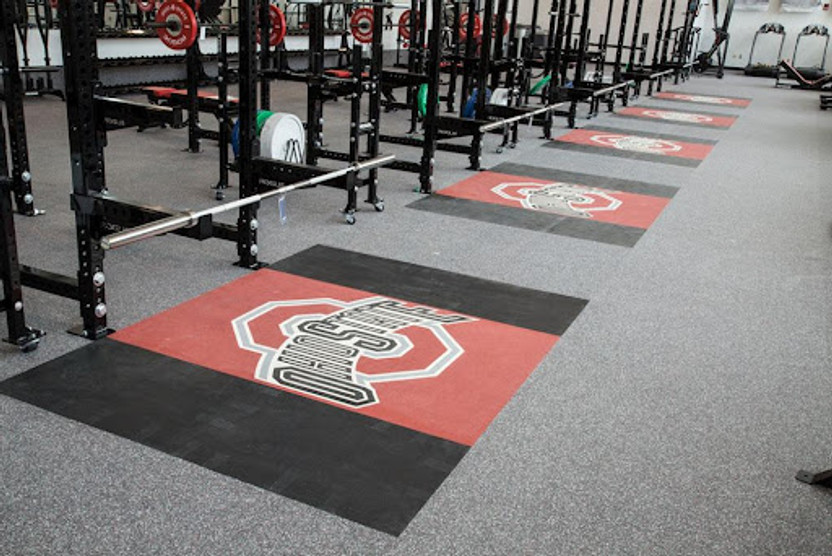Choosing the Best Flooring for Your Gym Space: Exploring Different Types of Flooring
2023 Aug 19th
When setting up a gym, one crucial factor that is often overlooked is the type of flooring that will best meet the function of the space. The right gym flooring plays a vital role in ensuring the safety, functionality, and comfort of the gym-goers, while also enhancing the aesthetics of the space. With numerous gym flooring options on the market, selecting the best flooring for your gym space can be a daunting task. In this blog, we’re going to explore a variety of different types of gym flooring and guide you on how to choose the right one for your needs.
1. Rubber Flooring:
Rubber flooring is a popular choice for gym spaces due to its durability, shock absorption, and sound insulation properties. It provides an excellent foundation for heavy gym equipment and protects the subfloor from damage. Rubber flooring is also slip-resistant, making it a safer option for high-intensity workouts and floor exercises. It is easy to clean and maintain, making it ideal for gyms with high foot traffic.
2. Vinyl Flooring:
Vinyl flooring has gained popularity in gyms for its versatility and affordability. It comes in various designs, patterns, and colors, allowing gym owners to customize the look of their space. Vinyl flooring is resistant to moisture, stains, and scratches, making it a durable option for gym areas whith frequent spills or heaving sweaing. However, vinyl flooring may not always be as shock-absorbent as rubber, so extra caution must be taken when using heavy gym equipment.
3. Gym Mat Flooring:
Gym mat flooring, also known as exercise mats or fitness mats, is a versatile option that provides excellent cushioning and support for various fitness activities. These mats come in different sizes and thicknesses, offering varying levels of comfort and impact absorption. Gym mats are ideal for grappling, combat sports, floor exercises, stretching routines, yoga, Pilates, and other bodyweight workouts. They can be easily moved and arranged, making them a convenient choice for creating designated workout spaces within your gym.
4. Turf Flooring:
Turf flooring, also known as artificial grass or synthetic turf, is a popular option for functional training areas and indoor sports facilities. It simulates the feel of real grass and provides a soft, natural surface that is perfect for functional movements, agility drills, and sled pushes. Turf flooring offers excellent shock absorption and is highly durable, withstanding heavy foot traffic and intense workouts. It also adds a visually appealing “outdoor touch” to your gym space, making it a favorite among fitness enthusiasts.
5. Interlocking Tiles:
Interlocking tiles come in various materials like rubber, vinyl, or foam and are designed for easy installation and customization. These tiles can be easily assembled and disassembled, making them a convenient option for gyms that require portability or quick setup changes. Interlocking tiles also offer good shock absorption and protect the underlying floor from the wear and tear of heavy foot traffic and other wear and tear.
How to Choose the Best Flooring for Your Gym:
Consider Gym Activities: Determine the primary activities that will take place in your gym. If it's a weightlifting-focused gym, rubber flooring or thick interlocking tiles are excellent choices. For a yoga and Pilates studios certain styles of vinyl flooring will likely be more suitable, and if you are outfitting a martial arts studio, gym mat flooring is often your best bet.
Durability: Assess the foot traffic and the type of equipment that will be used in the gym. Opt for flooring that can withstand heavy usage and is resistant to wear, moisture, and stains. If weightlifting is taking place, make sure you look towards shock and sound absorbing flooring.
Safety: Safety should be a top priority when selecting gym flooring. Look for flooring that offers slip resistance and ample shock absorption to prevent injuries during intense workouts.
Maintenance: Consider the ease of cleaning and maintenance. Gym spaces can get dirty quickly, so choose flooring that is easy to clean and disinfect regularly. Also ensure that if you expect heavy moisture or spills, that the flooring you choose is waterproof/resistant.
Aesthetics: While functionality is crucial, aesthetics also play a role in creating an inviting gym space. Choose flooring that complements the overall design and ambiance of the gym so that gym users can workout in a pleasing and stylish environment.
Budget: Make sure you set a budget for your gym flooring project. While some options may be more expensive upfront, they can save money in the long run due to their durability and low maintenance costs. High-quality gym flooring can last for years, and it’s always worth investing in flooring that won’t need frequent replacement.
Where can I find these different types of gym flooring?
Selecting the right flooring for your gym space is a decision that should not be taken lightly. Consider the type of activities, durability, safety features, maintenance requirements, aesthetics, and budget when making your choice. Whether it's rubber, vinyl, gym mat flooring, turf, or interlocking tiles, each type of gym flooring offers unique benefits to cater to different gym needs. By making an informed decision, you can create a safe, functional, and visually appealing gym space that will motivate and inspire gym-goers to achieve their fitness goals.
For all your gym flooring needs, Landmark Athletics has the solution. We have worked with major sports teams, professional and commercial gyms, and a diverse range of studios and home gym clients over the years to design flooring solutions that fit their every need. Visit our website today to explore our entire range of ready-to-roll and custom gym flooring options.

